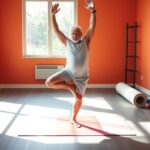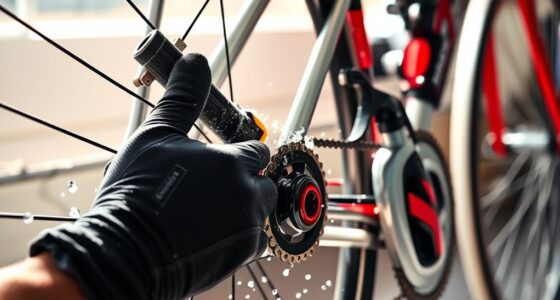To improve your cycling posture, focus on stretches and exercises that enhance flexibility and strengthen key muscles. Incorporate dynamic stretches like leg swings before rides to increase blood flow and reduce injury risk. After cycling, use static stretches targeting your hamstrings, hip flexors, and upper back for muscle recovery and relaxation. Strength training exercises like the Single-Leg Deadlift and TRX Low Row will help stabilize your core and upper back. Regular self-assessments can guarantee you maintain proper alignment. Stay tuned to discover more targeted techniques and routines for achieving the best cycling posture and performance.
Key Takeaways
- Incorporate dynamic stretches, like leg swings, before rides to enhance flexibility and reduce injury risk.
- Perform static stretches targeting hamstrings, quadriceps, and hip flexors post-ride for muscle recovery and improved flexibility.
- Focus on strengthening exercises, such as Single-Leg Deadlifts and TRX Low Rows, to improve core stability and upper back strength.
- Regularly assess your posture by checking weight distribution and ensuring head alignment to maintain a neutral spine while cycling.
- Ensure proper bike fit to support a relaxed upper body and neutral pelvis, enhancing cycling efficiency and comfort.
Understanding Cycling Posture
When it comes to cycling, maintaining the right posture can make all the difference in your performance and comfort. Proper cycling posture features a neutral pelvis, a relaxed upper body, and a straight up-and-down leg movement from the hips. This alignment helps reduce energy expenditure and enhances cycling efficiency, allowing you to ride longer without fatigue.
Additionally, embracing mindful decluttering in your environment can create a more peaceful space that encourages focus and relaxation, further supporting your cycling efforts.
Common postural issues like hunched shoulders and a forward head position can lead to neck, shoulder, and back pain if not addressed. To prevent these injuries, it's essential to keep your shoulder blades flat, shoulders relaxed, and your head aligned with your spine. By doing so, you'll not only improve your cycling posture but also promote injury prevention.
Regular self-assessment is key. Check your weight distribution and head alignment frequently to identify and correct imbalances. If you notice any tension in your upper body, take a moment to adjust your posture.
Engaging in targeted stretching and strengthening exercises can further enhance your flexibility and muscle balance, ensuring you're set up for ideal cycling posture. By focusing on these elements, you'll enjoy a more comfortable and efficient ride.
Importance of Stretching for Cyclists

Stretching is essential for enhancing your flexibility, which directly boosts your cycling performance.
By incorporating regular stretching into your routine, you can greatly reduce the risk of injuries caused by tight muscles. This proactive approach not only helps you ride longer and more comfortably but also keeps you in the saddle for years to come.
Additionally, avoiding summer evening flights can guarantee that you arrive at your cycling destinations feeling refreshed and ready to ride.
Enhanced Flexibility Benefits
Improving your flexibility through regular stretching can greatly enhance your cycling performance. Enhanced flexibility allows for a greater range of motion while pedaling, enabling you to generate more power and efficiency.
By incorporating stretching into your routine, you can address muscle imbalances that often develop from repetitive cycling movements, much like how proper hydration is essential for overall health. This not only helps you maintain proper posture on the bike but also promotes better alignment, which is significant for both aerodynamics and comfort during long rides.
Additionally, regular stretching plays an important role in reducing the risk of injuries related to tight muscles. When you stretch consistently, you're less likely to experience discomfort or strain that could sideline you.
Post-ride stretching is particularly effective, as it helps alleviate soreness and stiffness, allowing you to recover more quickly and prepare for your next ride.
Ultimately, maintaining flexibility through stretching supports your longevity in the sport, keeping your muscles healthy and preventing chronic issues.
Injury Prevention Strategies
Incorporating a consistent stretching routine into your cycling regimen is vital for injury prevention. Stretching enhances your overall cycling performance by improving flexibility, which helps you maintain proper posture and reduces muscle strain during rides.
Additionally, maintaining good indoor air quality can support your overall health, guaranteeing you have the best environment for recovery and performance, making an air purifier with health benefits a worthwhile consideration. Engaging in regular stretching routines can greatly lower the risk of injuries related to tight muscles, particularly in key areas like your hips, hamstrings, and lower back.
By including both dynamic and static stretching techniques, you promote faster recovery post-ride, alleviating soreness and aiding in muscle relaxation. Consistent stretching not only supports better posture while cycling but also guarantees your comfort and longevity in the sport.
It's essential for enhancing aerodynamics and cycling efficiency. Addressing muscle imbalances through targeted stretching and posture exercises helps prevent common cycling injuries associated with poor alignment.
You'll find that prioritizing injury prevention through stretching will lead to a more enjoyable and sustainable cycling experience. So, make stretching a regular part of your routine, and you'll reap the benefits of improved flexibility, reduced injury risk, and better overall performance on the bike.
Key Muscle Groups in Cycling
When you hop on your bike, several key muscle groups come into play, each contributing to your overall performance and comfort. Understanding these muscles can enhance your cycling experience and help you target specific areas for improvement.
| Muscle Group | Function | Importance in Cycling |
|---|---|---|
| Quadriceps | Extend the knee during the pedal downstroke | Primary power generators |
| Hamstrings | Aid in knee flexion and leg stabilization | Prevent injury and improve control |
| Glutes | Contribute to hip extension and power output | Enhance efficiency on inclines |
| Core Muscles | Provide stability and alignment | Prevent excessive rocking |
Your quadriceps are essential for pedaling power, while your hamstrings work to stabilize your legs and assist in knee movement. Strong glutes help propel you forward, especially on climbs and during sprints. Meanwhile, your core muscles keep your body aligned, reducing unnecessary movement that can lead to discomfort. By focusing on these muscle groups, you can improve your cycling posture and overall performance on the bike.
Effective Stretching Techniques

Effective Stretching Techniques
When you prepare for a ride, incorporating dynamic stretching techniques like leg swings and arm circles can greatly boost your blood flow and flexibility.
Including a low carb high protein breakfast prior to your ride can also enhance your energy levels and overall performance.
After your cycling session, static stretching for about 30 seconds can aid in muscle recovery and enhance your overall flexibility.
Focusing on these effective stretching methods won't only improve your cycling posture but also help prevent injuries.
Dynamic Stretching Benefits
Here is the revised MY ARTICLE SUBHEADING CONTENT:
Dynamic stretching techniques, like leg swings and arm circles, are vital for preparing your body for cycling. These stretches increase blood flow and enhance flexibility, particularly in key muscle groups.
Incorporating dynamic stretching into your pre-ride routine can markedly improve your cycling performance, much like how mastering key phrases in sign language enhances communication.
Here are some benefits of dynamic stretching:
- Increased range of motion: Dynamic stretches improve the flexibility of your hip flexors and quadriceps, essential for a smooth pedal stroke.
- Reduced injury risk: Warming up with dynamic movements helps warm your muscles, decreasing the likelihood of strains or sprains during your ride.
- Enhanced power output: Engaging the right muscles before cycling can boost your efficiency and power while pedaling.
- Better muscle coordination and balance: Regular dynamic stretching develops your overall control, leading to improved cycling posture and comfort.
Static Stretching Techniques
Static stretching techniques are essential for cyclists looking to improve their flexibility and alleviate muscle tightness. By holding stretches for at least 30 seconds, you effectively target key cycling muscles like the hamstrings, quadriceps, and hip flexors, which are vital for maintaining good posture on your bike.
Incorporating proper hamster care strategies can similarly enhance overall well-being and performance in any activity. After each ride, incorporate static stretching to release tension and promote muscle relaxation. This not only enhances recovery but also helps you align your body better for future rides.
Focus on major muscle groups, including your calves and upper back, to address tightness that can lead to poor cycling posture. Using props like yoga mats and blocks can make your stretches more comfortable and effective, allowing for deeper stretches.
Make a habit of practicing static stretching 2-3 times a week, and you'll see long-term improvements in flexibility. This consistency reduces the risk of injury and enhances your overall cycling performance.
Daily Stretching Routines

A daily stretching routine can be a game changer for your cycling posture and overall performance. Dedicating just 20 minutes each day to stretch can enhance flexibility and improve your alignment on the bike.
Regular stretching not only helps prevent injuries but also can complement other health practices like the benefits of apple cider vinegar for weight loss to boost your overall fitness. Focus on key muscle groups that often tighten during rides, like the hamstrings, hip flexors, and lower back.
Incorporate these elements into your routine for maximum cycling benefits:
- Dynamic stretches (before rides) to boost blood flow, such as leg swings and arm circles.
- Static stretches (after rides) to aid recovery and relieve tightness.
- Upper and lower body stretches to prevent muscle imbalances and guarantee proper alignment.
- Props like yoga mats and straps to help maintain form and maximize stretching benefits.
Strengthening Exercises for Posture

To improve your cycling posture effectively, incorporating strengthening exercises into your routine is crucial. Focusing on your upper back, core muscles, and glutes will create a solid foundation for maintaining proper cycling posture.
Nutrition's role in supporting muscle health and overall physical performance is essential as well. Start with the Single-Leg Deadlift, which targets your hips and glutes, promoting better balance and alignment. This exercise is fundamental for stability while cycling.
Next, include TRX Pike exercises to engage your core muscles and stabilize your pelvis. This helps prevent unwanted rocking and side-to-side movement during rides. Additionally, the TRX Low Row is fantastic for developing upper back strength, counteracting the rounded shoulders common among cyclists.
Regularly perform core-strengthening exercises like planks and bicycle crunches to enhance muscle engagement and stability, which are crucial for effective cycling mechanics.
Tailoring your routine to activate the core, glutes, and upper back addresses muscle imbalances that lead to poor cycling posture. By prioritizing these strengthening exercises, you'll not only improve your posture but also enhance your overall cycling performance, making every ride more enjoyable and efficient.
Self-Assessment for Posture Improvement

Improving your cycling posture doesn't stop with strengthening exercises; self-assessment plays an essential role in identifying and correcting misalignments. By regularly checking your posture, you can enhance your efficiency and comfort while cycling.
Additionally, consider how your overall indoor environment, including factors like air quality and temperature, can affect your energy levels during rides, as heat pumps can improve air quality. Here are some techniques to guide you:
- Check weight distribution on both feet to guarantee balance.
- Visualize a plumb line from head to ankle, making certain your hips stay level with a slight knee bend.
- Keep your head aligned and centered to reduce strain on your neck.
- Verify your shoulders are level to promote an open chest and neutral spine.
Incorporating self-assessment every 20-30 minutes while seated can prevent stiffness and reinforce good habits. Maintain eye level with your computer screen and support your forearms to further align your spine.
You might also consider consulting a physical therapist for personalized feedback on your posture improvement. Remember, incorporating movement and stretching during breaks can greatly enhance your overall posture and mobility, especially for those long hours on the bike.
Bike Fit and Its Impact

Proper bike fit plays an important role in achieving ideal cycling posture, directly impacting your comfort and performance on the bike. When your bike is fitted correctly, it aligns your body mechanics, allowing you to maintain a neutral pelvis and a relaxed upper body. This is essential for efficient pedaling and helps support the muscles around your back and shoulders.
Without a proper bike fit, you might find yourself hunched over, leading to poor posture characterized by a forward head position. This misalignment can increase the risk of injury, resulting in neck, shoulder, and back pain.
Regular assessments with a bike fit specialist are significant. They can help you adjust to any changes in flexibility, strength, or cycling style, promoting better posture and reducing strain on your muscles and joints.
Ultimately, a well-fitted bike enhances your cycling efficiency, allowing for maximum power generation and comfort, especially during long rides. Taking the time to make sure that your bike fit is spot-on can make all the difference in your cycling experience, keeping you injury-free and enjoying every ride.
Tools for Enhanced Stretching

Many cyclists find that incorporating the right tools can greatly enhance their stretching routine, making it more effective and enjoyable.
Using these tools not only increases comfort but also targets specific muscle groups, helping you recover and improve your cycling posture.
- Yoga Mat: Provides a comfortable surface for stretching and helps you maintain balance.
- Foam Roller: Essential for self-myofascial release, it alleviates muscle tightness and enhances flexibility before and after your rides.
- Resistance Bands: These are great for dynamic stretching, helping to build strength and flexibility in the muscles you use while cycling.
- FeetUp Trainer: This innovative tool facilitates hip-opening stretches and promotes better alignment, making your stretches more effective.
Frequently Asked Questions
How to Improve Cycling Posture?
To improve your cycling posture, focus on maintaining a neutral pelvis and relaxed upper body. Regularly assess your alignment, engage in dynamic warm-ups, and incorporate corrective exercises to enhance flexibility and overall body alignment.
Can You Fix Posture With Stretches?
Yes, you can fix posture with stretches. They help increase flexibility and balance muscle tension, allowing you to align your body better. Incorporating regular stretching into your routine promotes long-term improvements in posture and overall comfort.
How to Stretch Back for Cycling?
Picture your back unfurling like a blooming flower. To stretch your back for cycling, try shoulder blade releases, seated pigeon stretches, and supported downward-facing dog. These moves relieve tension and enhance your flexibility for better rides.
How Do I Strengthen My Neck for Cycling?
To strengthen your neck for cycling, try chin tucks and neck extensions. Incorporate resistance band neck retractions and perform lateral flexion stretches regularly. This'll enhance stability, improve alignment, and reduce strain during your rides.
Conclusion
By embracing these stretches and exercises, you'll not only enhance your cycling posture but also pave the way for more enjoyable rides. Think of it as giving your body a gentle tune-up, ensuring every pedal stroke feels smooth and effortless. As you incorporate these practices into your routine, you'll discover a newfound freedom on your bike, transforming each journey into a delightful dance with the road. So, gear up and let your body sing with each ride!
















